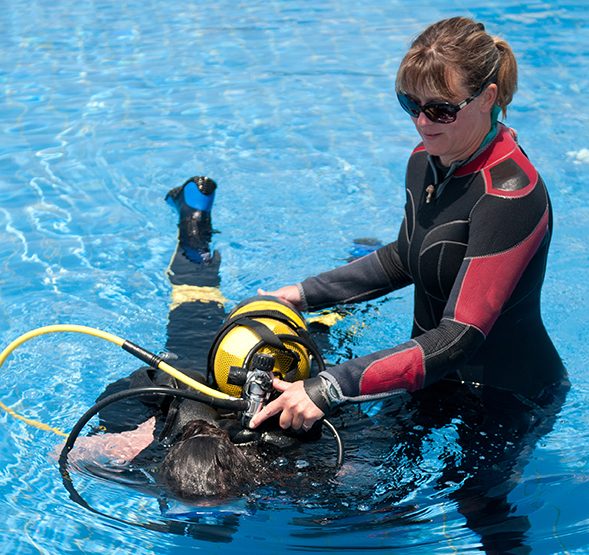CREATING A SAFER
CONFINED WATER
TRAINING AREA

SAFETY IN CONTAINED WATER is extremely important because this is typically where an open water scuba student takes their first breath underwater. But confined-water training areas can be hazardous due to slippery floors, heavy cylinders, and inexperienced students who are still learning the ropes. By conducting an assessment and noting potential issues, you can create a safe training area for these new divers.
ASSESS YOUR SITE
If your confined water site is not a swimming pool, make sure to assess the conditions to ensure they are calm and clear without any currents or hazards. Entry and exit points should be easily accessible and identifiable. Most importantly, it should be conducive to safe and effective learning. Whether your confined water training area is a pool or another site, it should be at a temperature that is comfortable to students, and adequate exposure protection should be used.
ASSESS YOUR
EMERGENCY PROCEDURES
Emergency preparedness during confined water training is essential, especially when you must navigate a slippery pool deck in wet garments. Map out the evacuation route and be sure to explain it to new students. If the confined water area is attached to your shop, be sure to have emergency evacuation routes posted in a clearly visible area.
ASSESS THE CLEANLINESS
OF YOUR SPACE
Keeping students feeling safe and comfortable is an important part of teaching scuba. It doesn’t matter if they are taking their very first breath underwater or completing divemaster training — safety and comfort should be your top priorities. Look around — is your pool deck cluttered with miscellaneous items? A cluttered or dirty pool deck can give the wrong impression to people diving with you and create a potentially hazardous space. If, while in the confined water area, students will see a fill station or rental area, are these clean and orderly, too? Be sure that the fill station is marked so that students don’t linger near cylinders, and be sure the rental area is free of clutter that could make selecting equipment hazardous.
While preventative actions such as organizing your pool deck may not seem important, it is an important step in preventing and reducing accidents. Simple organization and planning can eliminate hazards quickly and easily. These assessments can be completed during non-business hours or during a period of slow foot traffic.
DAN Customer Service
Mon–Fri, 8:30 a.m. – 5 p.m. ET
+1 (919) 684-2948
+1 (800) 446-2671
Fax: +1 (919) 490-6630
24/7 Emergency Hotline
In event of a dive accident or injury, call local EMS first, then call DAN.
24/7 Emergency Hotline:
+1 (919) 684-9111
(Collect calls accepted)
DAN must arrange transportation for covered emergency medical evacuation fees to be paid.
Medical Information Line
Get answers to your nonemergency health and diving questions.
Mon–Fri, 8:30 a.m. – 5 p.m. ET
+1 (919) 684-2948, Option 4
Online: Ask A Medic
(Allow 24-48 hours for a response.)
